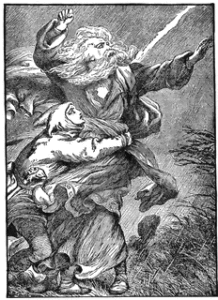 I’m trying to think of plays where the weather plays an important role. Sure there’s The Tempest, but we get the storm at the beginning and then…nothing.
I’m trying to think of plays where the weather plays an important role. Sure there’s The Tempest, but we get the storm at the beginning and then…nothing.
Macbeth seems to be all about the weather. So fair and foul a day I have not seen!
King Lear is probably the ultimate example. If you haven’t seen Act 3 Scene 1 live yet, your Shakespeare life is not complete. The wind is blowing, the rain is pouring down. Kent staggers in at one level, battling against the wind, hanging on to the scaffolding so he doesn’t blow away. Enter a gentleman below, also buffeted by the wind. “Where’s the king?” first thing Kent asks, only to learn that he’s out in this storm. “But who is with him?” “None but the fool.” Shivers. Goosebumps. That’s one of my favorite moments in the play.
Hey, here’s a question — the stage direction I read for this scene says “Storm still.” Does that mean the storm is still continuing, or that there is a lull in the storm, an actual still moment?
What else? Any of the comedies do something similar to work weather into the plot?

Still almost always means constantly” or “always” in Shakespeare (occasionally in the adjectival sense, “constant, continuous”). In context, it may mean “silent,” but this would be a very unusual construction for Shakespeare and I am quite sure it is intended to mean “Storm constantly.”